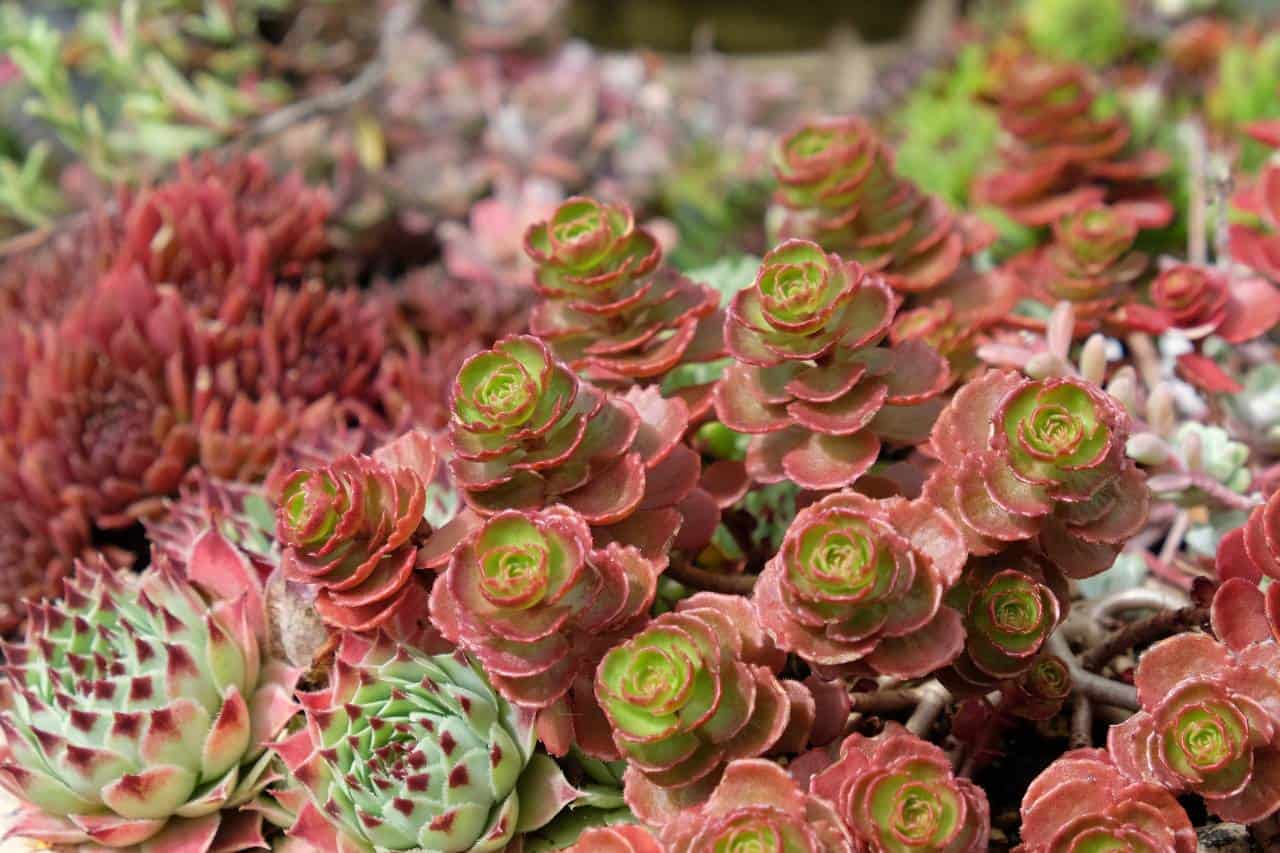Dragon’s Blood Sedum, also known as Dragon’s Blood Stonecrop or Shorbuser Blut, is a unique succulent known for its vibrant color. This succulent was previously known as Sedum spurium but is now referred to as Phedimus spurius.
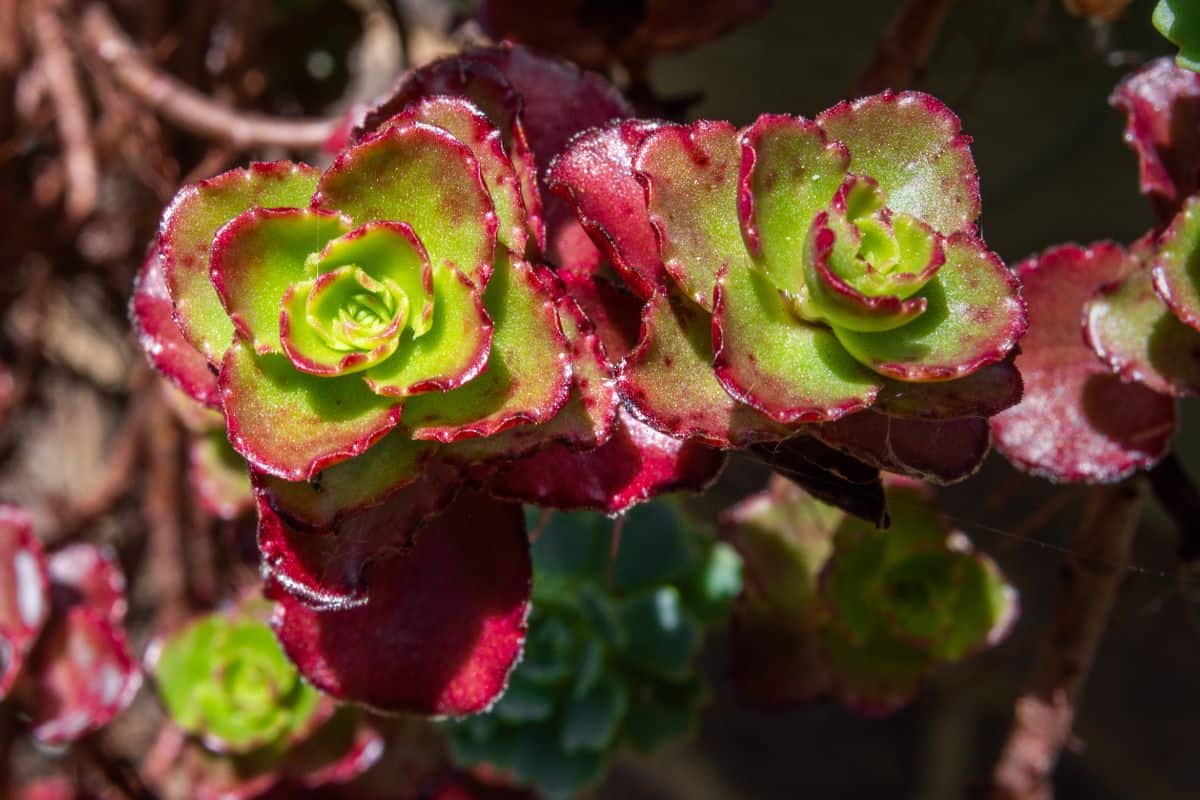
This colorful species gets its name from its blood-red foliage. The leaves actually start out in the spring as a deep green with purplish-red on the leaf margins. By fall, the leaves have darkened to the deep wine-red color the species is known for.
If you can provide the right type of care, Dragon’s Blood Sedum blooms in mid-summer to mid-fall. The clustered flowers are star-shaped and may be various shades of pink and red.
During the winter, it’s common for this succulent to lose its leaves as it approaches its winter dormancy, so don’t be surprised to see your Dragon’s Blood Sedum start to drop leaves as cold weather approaches.
Dragon’s Blood is not the only variety of Phedimus spurius. There are other cultivars including Album Superbum, Fludgaglut, John Creech, Tricolor, and Voodoo. Dragon’s Blood tends to be the slowest growing P. spurius variety.
Dragon’s Blood Sedum is easy to care for and is ideal for gardeners of any experience level. However, it’s important to note that this species is mildly toxic, so be careful if you have children or pets in your home
| Name: | Phedimus spurius |
| Soil: | Well-draining soil |
| Blooming: | Early Summer to Late Summer |
| Light: | Brightlightto full sun |
| Water: | Allow the soil to dry out again before the next watering |
| Propagation: | Stem cuttings |
Water
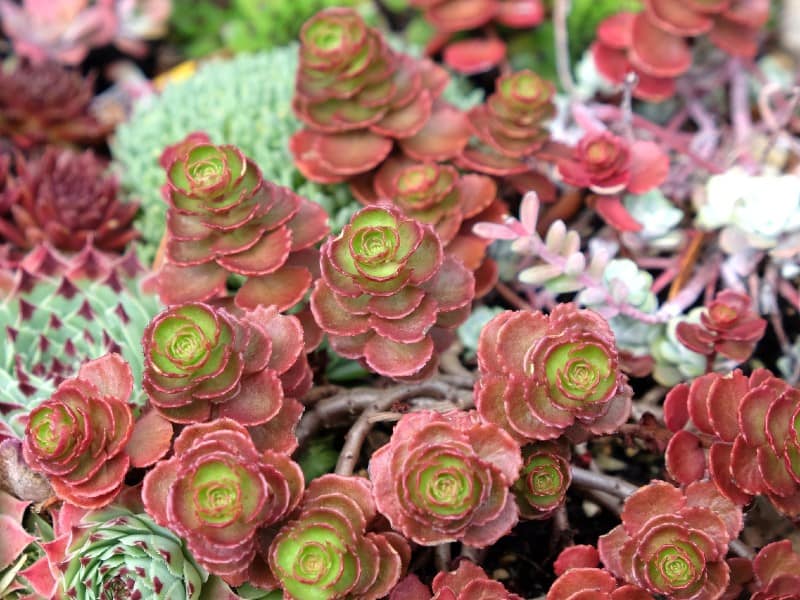
Buy it from:
Like most succulents, Dragon’s Blood Sedum prefers to be watered sparingly as it is sensitive to overwatering. The best way to accomplish this is to use the soak and dry watering method. Soak the soil to the point where the excess drains from the bottom of the pot, then allow the soil to thoroughly dry out again before the next watering.
If the soil is not allowed to dry out between watering, the wet environment will encourage root rot to develop. Unfortunately, root rot is rarely visible above the surface of the soil until the plant is too far gone to be saved.
The key to successful use of the soak and dry method is to check the soil before you water, rather than relying on a set watering schedule. By checking the soil, you account for changes in temperature and humidity that may affect how quickly the soil dries.
You may check the soil using your finger or a soil moisture meter if you prefer more high-tech tools. Simply insert your tool of choice a couple of inches into the soil near the base of your Dragon’s Blood.
If the soil is dry, you can water without hesitation. If the soil is moist, it’s best to wait a few days before checking again. Otherwise, you risk accidentally giving your plant too much water. While the occasional instance of overwatering may be forgiven, repeatedly giving your succulent too much water will be a problem.
You’ll also need to adjust your watering schedule according to the season and weather. Hot, dry weather will mean more frequent watering, while cool or humid weather will mean less frequent visits with your watering can.
No products found.
Additionally, Dragon’s Blood Sedum goes dormant in the winter. As stated earlier, this species will lose its leaves in the fall and is one of the few species of succulents that can withstand winter temperatures.
During this winter dormancy period, the plant is not actively growing and requires little to no moisture during this time. You can resume watering in the spring when new leaves sprout, and the plant once again begins its active growth season.
Light
When kept indoors, Dragon’s Blood Sedum grows best in bright light. It is not a low-light succulent. A south or west-facing will be ideal in providing your succulent with adequate light. An east-facing window may also work, but a north-facing window will not be able to provide enough light.
Without adequate light, your Sedum will become etiolated or stretched out. Etiolation is not harmful, but it’s not an attractive look for your plants. They will grow long stems with large spaces between leaves. The stems will also lean toward the nearest source of light.
Unfortunately, etiolation cannot be repaired, so if you do not have enough light in your indoor space, you’ll need to prevent it by investing in a grow light. Full-spectrum grow lights are the artificial version of natural sunlight and come in a wide range of shapes and sizes.
Dragon’s Blood Sedum may also be grown outdoors in most climates. When grown outside, it will grow best in full sun. Full sun will also help to develop that deep burgundy color that the species is known for.
However, caution should be taken when introducing your Sedum to the outdoors. Moving your plant into the full sun after it has lived comfortably indoors will likely result in sunburn. Instead, slowly increase the amount of light your succulent is exposed to over the course of several weeks.
Like etiolation, sunburn damage is a cosmetic issue, but prolonged exposure to too much light can be fatal. By giving your Sedum time to adapt, you’re reducing your succulent’s chances of cosmetic damage and death.
If you live in a particularly hot climate, you may also want to provide your Dragon’s Blood with a bit of shade during the hottest hours of the afternoon. Although this species typically does well in direct sunlight, extreme heat can increase the possibility of sunburn.
Temperature
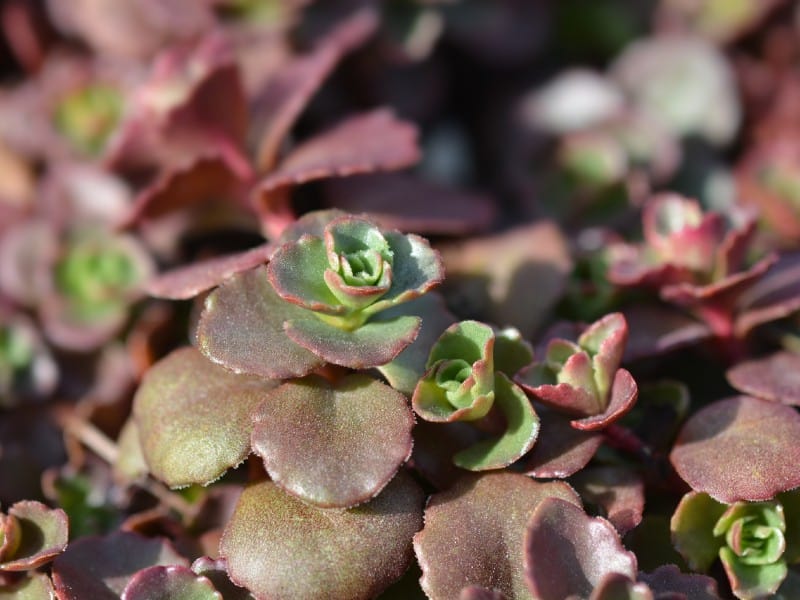
As previously mentioned, Dragon’s Blood Sedum is among the few species of succulents that can withstand the frigid temperatures of winter. It is able to survive temperatures as low as -30 degrees Fahrenheit.
While you may need to bring more sensitive succulents indoors for the winter, Dragon’s Blood may be safely left outdoors year-round in all but the coldest climates. During this period of dormancy, you don’t need to worry about frequent watering either as the plant is not actively growing and will not use the moisture effectively anyway.
This species is also tolerant of extreme heat, but as mentioned earlier, it may need to be shaded during the hottest part of the day. You will also need to water your Dragon’s Blood more frequently during heat waves to prevent wilting.
If you plan on growing Dragon’s Blood Sedum indoors, you won’t need to worry about temperatures. However, it’s still recommended to keep your plants away from sudden drafts or changes in temperature as this can cause unnecessary stress.
Soil
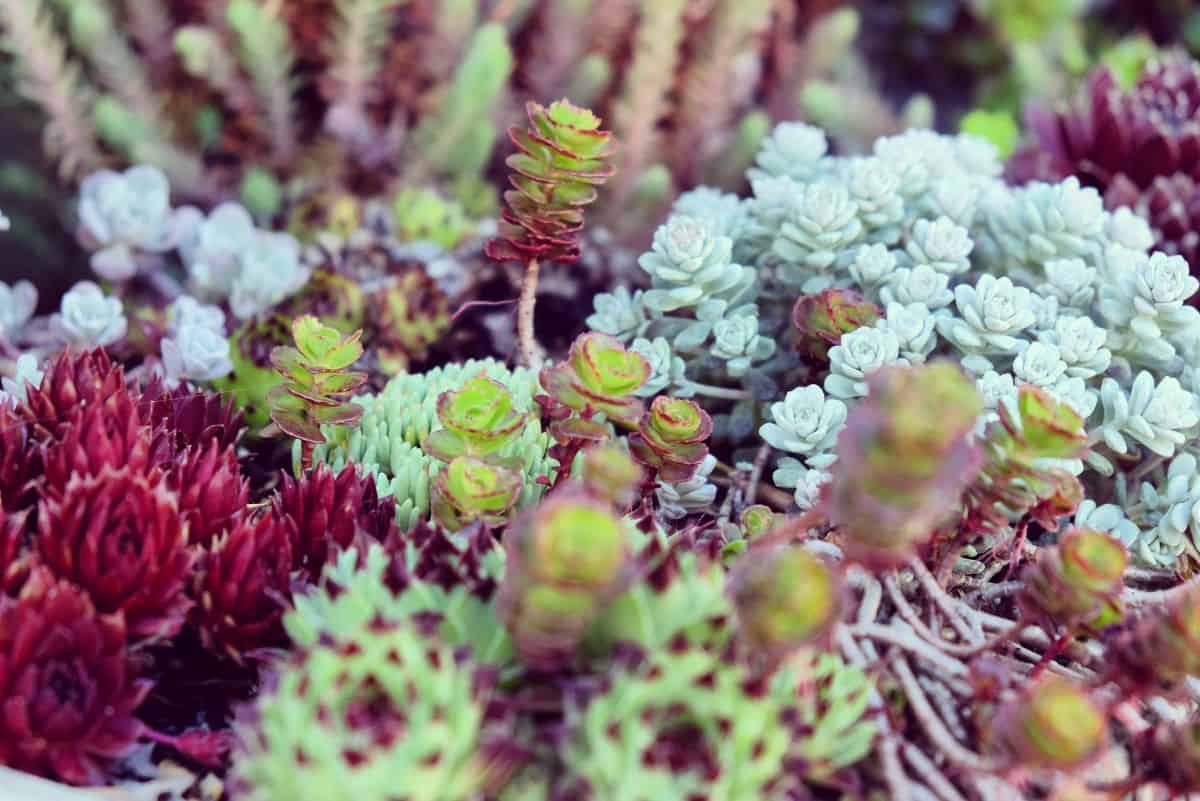
Like other species of Sedum and Phedimus, Dragon’s Blood grows best in well-draining, porous soil. If you’re shopping for a commercially available soil mix, look for one formulated for succulents and cacti.
Succulent and cactus soil generally provides the drainage and airflow necessary for Sedum to thrive. Ingredients such as coarse sand, gravel, perlite, and pumice prevent unnecessary water retention.
Small amounts of ingredients such as clay, peat moss, and coconut coir are acceptable, but large amounts should be avoided as the soil may then retain too much moisture. This will cause the soil to take longer to dry out and your succulent will be at risk of rotting.
If you have a soil mixture formulated for use with vegetables or flowers, you will need to make adjustments to it with the addition of a gritty mineral mix. Most gardeners recommend a total of 50-70% mineral grit.
Some organic material is necessary in the mix as it provides your Dragon’s Blood with much-needed nutrients. The more mineral grit, the fewer available nutrients, so if you’re using a particularly gritty mix, you’ll need to occasionally replenish the soil with fertilizer or repot the plant.
Since this is the slowest growing variety of Phedimus spurius, you will not need to repot frequently, but it is recommended if the plant appears to be struggling.
It is recommended to fertilize your Sedum in the spring as it begins active growth once again. Fertilizing in winter is not recommended as the plant cannot use the nutrients during dormancy. Too much fertilizer should also be avoided as it will result in leggy and uneven growth.
Container
When choosing your ideal container for Dragon’s Blood Sedum, be sure to choose a pot with appropriate drainage. Although it is technically possible to grow succulents in containers without drainage holes, it’s not recommended.
Most gardeners are not precise enough in their watering habits to accommodate a pot without drainage. If the excess water has nowhere to go, it’s easy to accidentally overwater. Over time, this will expose your succulent roots to too much moisture and it may rot.
You’ll also need to consider the material your pot is made out of as it will also affect your watering schedule.
Terra cotta pots absorb excess moisture from the soil, which can be a good or bad thing, depending on your watering habits. They are a favorite of many gardeners, but they aren’t the most exciting or decorative containers.
Glazed ceramic or plastic pots do not absorb water from the soil, but they are available in a much wider range of colors and patterns to suit your décor. Just remember that darker-colored pots will absorb more heat than lighter colors and may dry out more quickly when exposed to the sun.
As long as your pot has drainage holes, it rarely makes a difference in the growth of the plant as long as you adjust your watering schedule accordingly. Dragon’s Blood Sedum may also be planted directly in the ground if you would prefer to skip the container altogether.
Care Tips
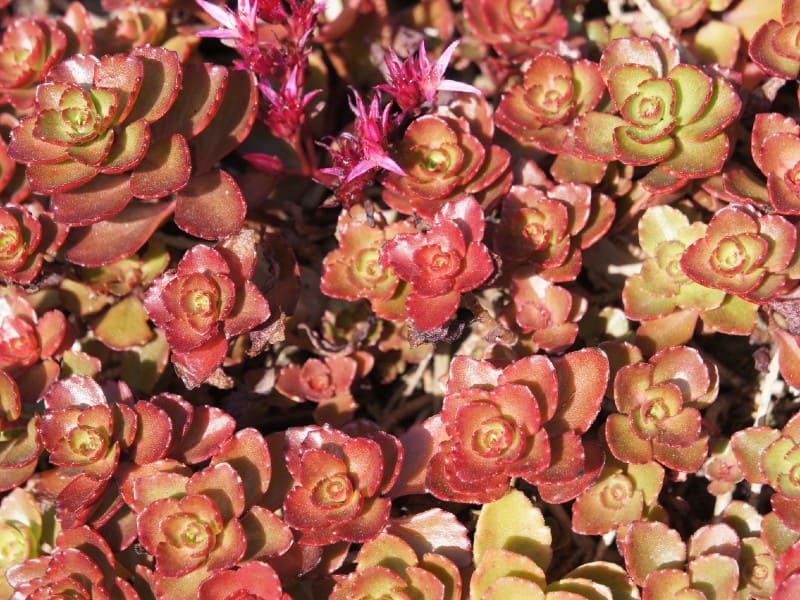
If you would like to fertilize your Dragon’s Blood Sedum, it’s recommended to do so only once or twice during each growing season. This frequency will be enough to provide the plant with necessary nutrients but won’t be enough to encourage incorrect growth.
It’s recommended to use a fertilizer formulated specifically for succulents. These fertilizers tend to be lower in nitrogen than other types of fertilizer. High nitrogen levels can cause the plant to stop taking up potassium.
Potassium is essential in keeping succulents healthy and moving nutrients and water through the length of the plant. Additionally, it increases the plant’s disease resistance and promotes even, healthy growth.
Fertilizers formulated for use with succulents and cacti will have the correct balance of nitrogen, potassium, and phosphorus to ensure that your Dragon’s Blood grows at a healthy rate.
It’s also worth noting that Dragon’s Blood Sedum is incredibly easy to propagate, so if you’re looking for a colorful ground cover, or simply want to share your favorite plant with friends and family, you can do so by snipping a few healthy cuttings and planting in well-draining soil.
Sedum are notorious for rooting relatively quickly, so you may find propagation to be particularly easy. However, if you’re interested in faster root growth, you can always dip your Dragon’s Blood cuttings in rooting hormone powder prior to planting.


